Biržų alus, "craft" lager brewers
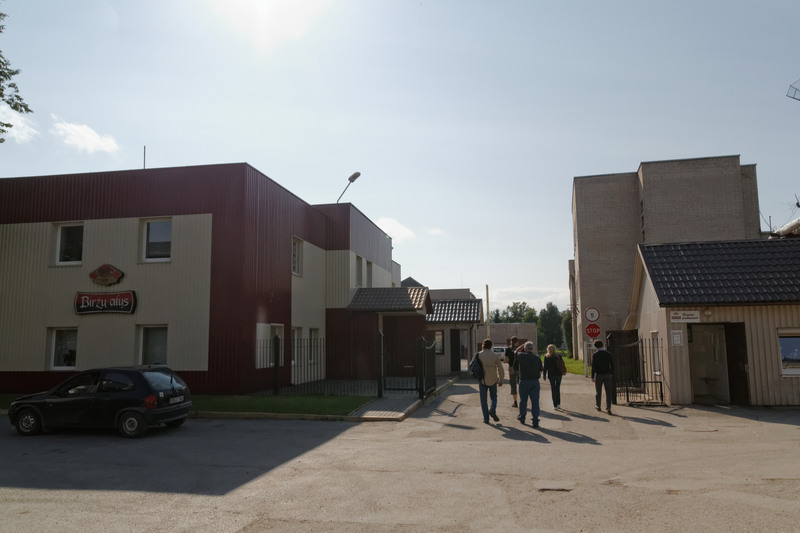
The brewery |
We roll into Biržai, a small, slightly run down, provincial town in northern Lithuania. It's famous in Lithuania as "the capital of beer", both for all the home brewers, and for the commercial brewers in the town. Biržų Alus, which we're visiting, is clearly no small brewery, since it's housed in a cluster of older buildings around a big yard. (This is part 4 of the Lithuanian brewery tour.)
As we pass through the gate we are met by the marketing manager, young, tanned, and fit. A little later, we're joined by the production manager, a slim, fit woman in her forties, looking very capable, with a quick, bird-like manner. They show us into the brewery right away, and immediately I see what Vidmantas meant, when he said it's a Soviet-era brewery. The boiling kettles are old, with a painted rough matte surface. The shape is the same as modern kettles, but no gleaming copper here.
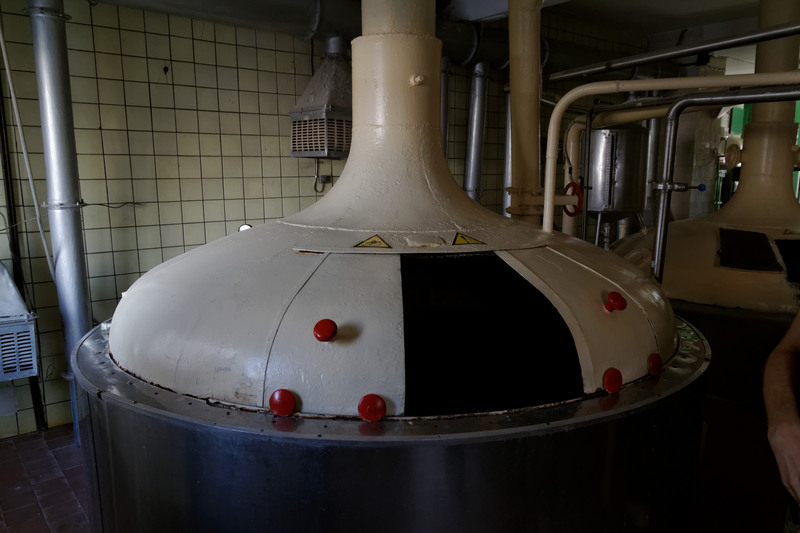
The kettles |
Afterwards we go through some corridors, and emerge into a huge hall, so cold I immediately get goosebumps, and start shivering. This is where they do fermentation and lagering, so clearly this is a lager brewery. The vessels are all shining brushed steel. The marketing manager explains that these tanks were installed just a couple of years ago.

Modern fermenters |
Afterwards we go down into the cellar, which is centuries old. The brewery in fact goes back to 1686, when it was founded by a member of the Radvilu family, one of the foremost noble families of the Polish-Lithuanian Commonwealth. Their position is perhaps best judged by the family residence in what is today Belarus being a World Heritage site, and the 1528 military census listing them as in control of 12,160 villages.
Anyway, the cellar is naturally cooled, by being underground, and by having 5-meter thick walls. Down here we see Soviet-era fermentation tanks, still in use, with similar paint as on the kettles. This is interesting. Using cellars to produce naturally-cooled lager is not very common any more, but before the invention of refrigeration it used to be the only way.
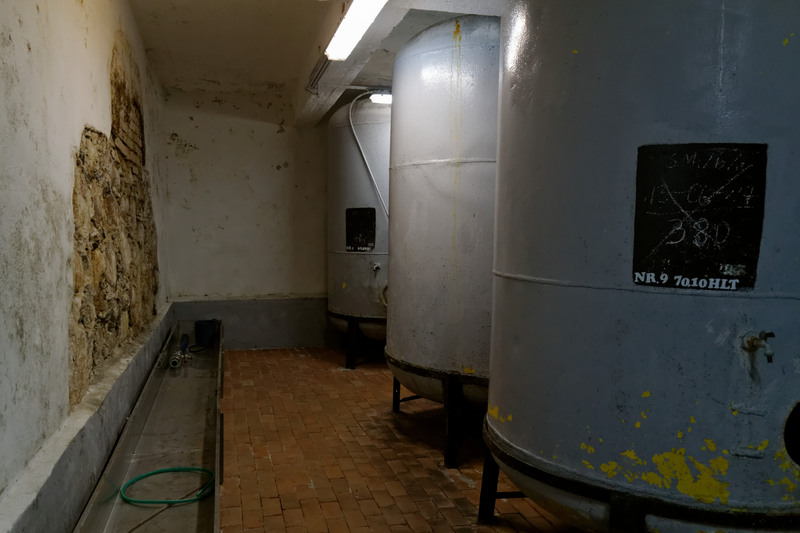
Old fermenters |
They explain that the brewery makes only lagers, and that except for the Radvilų, none of their beers use sugar. They give annual output as 5000 tons, which we quickly translate into 5 million liters. They've actually expanded a lot, and did only 1 million liters in 2003. Don and I are confused by this, because the brewery is so big, it really looks like it should produce more. So I ask them how long they mature the beer, and they say 15-90 days. And there's the answer: if you're going to do it the correct, but expensive, way, you need a big brewery even if the output is not that big.
They also explain that they do no high-gravity brewing. That is, they don't brew a strong high-gravity beer and then water it down to the sales strength to save cost. Indeed, on the marketing DVD they give us is a big "no high gravity" logo. That's actually a good idea. Brewers producing lager the right way should use that fact in their marketing, and tell consumers what they are getting. It's a great way to differentiate yourself.
They use Lithuanian malts, they say, German hops, both pellets and leaves. The yeast is from Italy. They've made an experimental beer at 15%, they say, all naturally fermented. Sadly, we never got to try it. Then they start telling anecdotes. Apparently the owners lost the brewery at cards at one point, centuries ago.
During the war the Soviets took Biržai very quickly, and the brewery was chosen as the only suitable place to quarter the troops. This proved to be unwise, as the troops quickly got hold of the beer, and got roaring drunk. The locals informed the Germans, who easily retook the town. They giggle at this, as if being reconquered by the Nazis were a real coup, but I think it's more a feeling of "haha, that's one on the nose for the Soviets". If you stop to think about it, it's a reminder that for people in Eastern Europe, none of the two likely outcomes of World War II could be counted as a real victory.
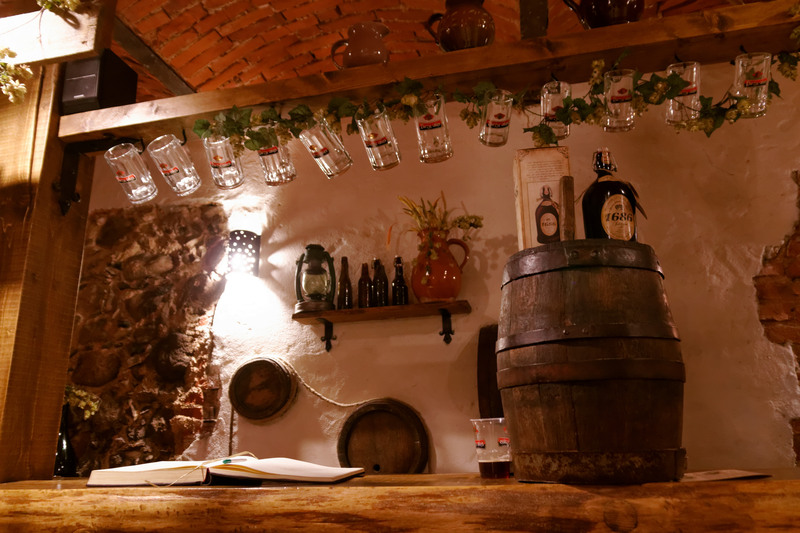
The bar |
Anyway, they lead us into a tasting room in another ancient brick cellar, this one looking much like a classy cellar bar in Vilnius. They have a number of beers in PET bottles, and a couple draft. Snacks of various kinds are included, too. I notice our hosts take little glasses of beer, drinking what seems to be token amounts, to fulfill their duties as hosts, while still being able to work afterwards.
Their beers are a mixed bunch. The Širvenos attracted a bit of attention earlier this year, for being brewed with peas. They explain that this originated in Soviet times, when there was not always enough malts. I'm confused about this, and say, "you know, you don't really make it sound like a good thing." They admit it was not at all good then, but laugh and say "it's tradition now." And that actually makes perfect sense. The first times people were eating half-rotten fish it probably wasn't a good thing, either, but in time it developed into a delicacy and a tradition.
Today only 5% of the grist is peas, and they use fresh, green peas from nearby farms. It doesn't really add much in the way of flavour, but fills out the body and softens the mouthfeel. A bit like using wheat or oats, I guess. Anyway, Širvenos is not really a terribly remarkable beer, but it does have the Lithuanian character, and it's in no way a bad beer.
They also brew an 8% strong lager called Stiprusis (strong). This is almost to be considered as a style, because as they explain the legal limit for beers in plastic bottles (the cheapest packaging) is 8%, so a number of brewers make these. They're really aimed at people who want to get drunk cheaply, which is a market that produces a reliable income.

Tasting |
They say they actually sell this beer under 8 different labels (I think I got the number right), because people will often take against a specific brand, saying "no, no, that one gives me a headache". As they say, it's the amount you drink that does that, not something in the beer.
Anyway, Stiprusis is not their best beer. Their standard pale lager is pretty good, and the jubilee beer in 1-liter bottles is also quite good. A new beer they were quite proud of is Grafo (again named after their noble founder), an unpasteurized lager to be sold draft only.
They gave us a whole bunch of plastic bottles as gifts, and I went through the ones I hadn't tried before in my hotel room a few days later. I intended to just have a glass of each, but as I was going through the Grafo I'd say to myself "you know, this is actually pretty good." So I'd do another tiny glass, and find another little facet of the flavour I hadn't spotted before. In the end I went through the whole 0.5l bottle, enjoying it all the way.
So, given all of this, how is one to classify Biržu Alus? To me, they are a high-end lager brewer, much like, say, Hacker-Pschorr, but working in a Lithuanian tradition, and producing typically Lithuanian flavours. Strawy, earthy, slightly sweet lagers.
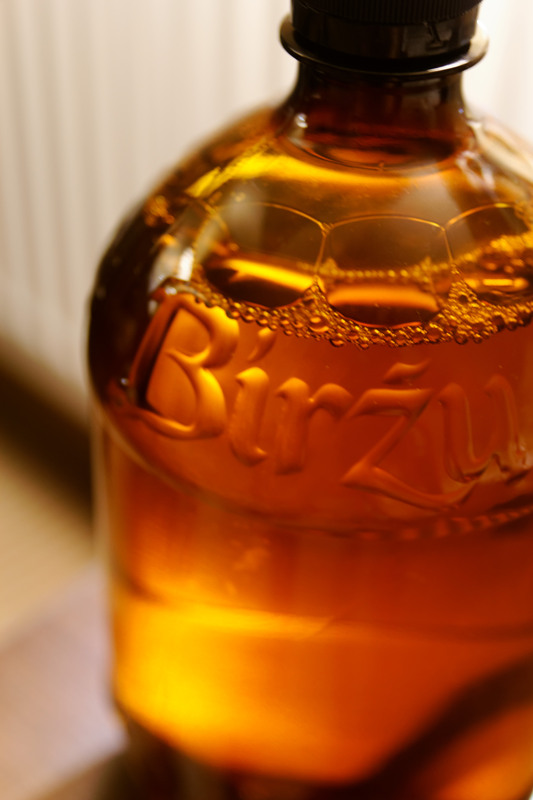
A bottle of Grafo |
As we're sitting in the tasting room, Don starts talking about how he's been trying to explain to Americans that unfiltered, unpasteurized lager is a completely different drink, far better than the usual variety. This clearly strikes a chord with the marketing manager, because on the way back to the car he tells me he's never had an unpasteurized, unfiltered lager before we sampled it from the tank just now, and he really liked it.
I tell him I totally agree with Don that this type of lager can be a thing of true greatness, and always better than the filtered, dead variety. "But", I ask him, "what about durability?" "Yeah," he says, "that's a problem." And it is. It's actually a general problem for Lithuanian craft brewers that their fresh beers are often amazing, while what you get in pubs in Vilnius is often merely good, and sometimes worse.
Similar posts
Vasaknų Dvaro, a manorial brewery
"The 'dvaro' in 'Vasaknų Dvaro', means manor house," the interpreter explains
Read | 2013-08-12 14:51
Interview with Simonas Gutautas of Dundulis
During my last trip to Lithuania I met Simonas Gutautas, who works for the Dundulis brewery
Read | 2015-05-11 14:12
Comments
No comments.